Junyu Gao
Secure Tug-of-War (SecTOW): Iterative Defense-Attack Training with Reinforcement Learning for Multimodal Model Security
Jul 29, 2025Abstract:The rapid advancement of multimodal large language models (MLLMs) has led to breakthroughs in various applications, yet their security remains a critical challenge. One pressing issue involves unsafe image-query pairs--jailbreak inputs specifically designed to bypass security constraints and elicit unintended responses from MLLMs. Compared to general multimodal data, such unsafe inputs are relatively sparse, which limits the diversity and richness of training samples available for developing robust defense models. Meanwhile, existing guardrail-type methods rely on external modules to enforce security constraints but fail to address intrinsic vulnerabilities within MLLMs. Traditional supervised fine-tuning (SFT), on the other hand, often over-refuses harmless inputs, compromising general performance. Given these challenges, we propose Secure Tug-of-War (SecTOW), an innovative iterative defense-attack training method to enhance the security of MLLMs. SecTOW consists of two modules: a defender and an auxiliary attacker, both trained iteratively using reinforcement learning (GRPO). During the iterative process, the attacker identifies security vulnerabilities in the defense model and expands jailbreak data. The expanded data are then used to train the defender, enabling it to address identified security vulnerabilities. We also design reward mechanisms used for GRPO to simplify the use of response labels, reducing dependence on complex generative labels and enabling the efficient use of synthetic data. Additionally, a quality monitoring mechanism is used to mitigate the defender's over-refusal of harmless inputs and ensure the diversity of the jailbreak data generated by the attacker. Experimental results on safety-specific and general benchmarks demonstrate that SecTOW significantly improves security while preserving general performance.
WebUIBench: A Comprehensive Benchmark for Evaluating Multimodal Large Language Models in WebUI-to-Code
Jun 09, 2025Abstract:With the rapid advancement of Generative AI technology, Multimodal Large Language Models(MLLMs) have the potential to act as AI software engineers capable of executing complex web application development. Considering that the model requires a confluence of multidimensional sub-capabilities to address the challenges of various development phases, constructing a multi-view evaluation framework is crucial for accurately guiding the enhancement of development efficiency. However, existing benchmarks usually fail to provide an assessment of sub-capabilities and focus solely on webpage generation outcomes. In this work, we draw inspiration from the principles of software engineering and further propose WebUIBench, a benchmark systematically designed to evaluate MLLMs in four key areas: WebUI Perception, HTML Programming,WebUI-HTML Understanding, and WebUI-to-Code. WebUIBench comprises 21K high-quality question-answer pairs derived from over 0.7K real-world websites. The extensive evaluation of 29 mainstream MLLMs uncovers the skill characteristics and various weakness that models encountered during the development process.
LLMs Caught in the Crossfire: Malware Requests and Jailbreak Challenges
Jun 09, 2025Abstract:The widespread adoption of Large Language Models (LLMs) has heightened concerns about their security, particularly their vulnerability to jailbreak attacks that leverage crafted prompts to generate malicious outputs. While prior research has been conducted on general security capabilities of LLMs, their specific susceptibility to jailbreak attacks in code generation remains largely unexplored. To fill this gap, we propose MalwareBench, a benchmark dataset containing 3,520 jailbreaking prompts for malicious code-generation, designed to evaluate LLM robustness against such threats. MalwareBench is based on 320 manually crafted malicious code generation requirements, covering 11 jailbreak methods and 29 code functionality categories. Experiments show that mainstream LLMs exhibit limited ability to reject malicious code-generation requirements, and the combination of multiple jailbreak methods further reduces the model's security capabilities: specifically, the average rejection rate for malicious content is 60.93%, dropping to 39.92% when combined with jailbreak attack algorithms. Our work highlights that the code security capabilities of LLMs still pose significant challenges.
Scale Efficient Training for Large Datasets
Mar 17, 2025Abstract:The rapid growth of dataset scales has been a key driver in advancing deep learning research. However, as dataset scale increases, the training process becomes increasingly inefficient due to the presence of low-value samples, including excessive redundant samples, overly challenging samples, and inefficient easy samples that contribute little to model improvement.To address this challenge, we propose Scale Efficient Training (SeTa) for large datasets, a dynamic sample pruning approach that losslessly reduces training time. To remove low-value samples, SeTa first performs random pruning to eliminate redundant samples, then clusters the remaining samples according to their learning difficulty measured by loss. Building upon this clustering, a sliding window strategy is employed to progressively remove both overly challenging and inefficient easy clusters following an easy-to-hard curriculum.We conduct extensive experiments on large-scale synthetic datasets, including ToCa, SS1M, and ST+MJ, each containing over 3 million samples.SeTa reduces training costs by up to 50\% while maintaining or improving performance, with minimal degradation even at 70\% cost reduction. Furthermore, experiments on various scale real datasets across various backbones (CNNs, Transformers, and Mambas) and diverse tasks (instruction tuning, multi-view stereo, geo-localization, composed image retrieval, referring image segmentation) demonstrate the powerful effectiveness and universality of our approach. Code is available at https://github.com/mrazhou/SeTa.
From Captions to Rewards (CAREVL): Leveraging Large Language Model Experts for Enhanced Reward Modeling in Large Vision-Language Models
Mar 08, 2025Abstract:Aligning large vision-language models (LVLMs) with human preferences is challenging due to the scarcity of fine-grained, high-quality, and multimodal preference data without human annotations. Existing methods relying on direct distillation often struggle with low-confidence data, leading to suboptimal performance. To address this, we propose CAREVL, a novel method for preference reward modeling by reliably using both high- and low-confidence data. First, a cluster of auxiliary expert models (textual reward models) innovatively leverages image captions as weak supervision signals to filter high-confidence data. The high-confidence data are then used to fine-tune the LVLM. Second, low-confidence data are used to generate diverse preference samples using the fine-tuned LVLM. These samples are then scored and selected to construct reliable chosen-rejected pairs for further training. CAREVL achieves performance improvements over traditional distillation-based methods on VL-RewardBench and MLLM-as-a-Judge benchmark, demonstrating its effectiveness. The code will be released soon.
A Benchmark for Multi-Lingual Vision-Language Learning in Remote Sensing Image Captioning
Mar 06, 2025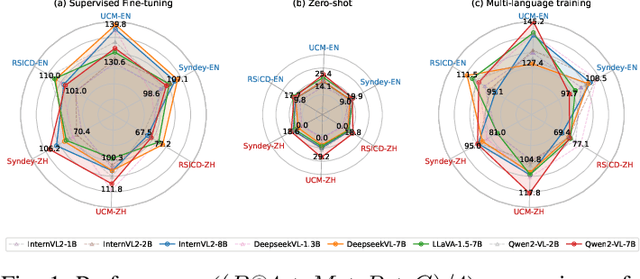
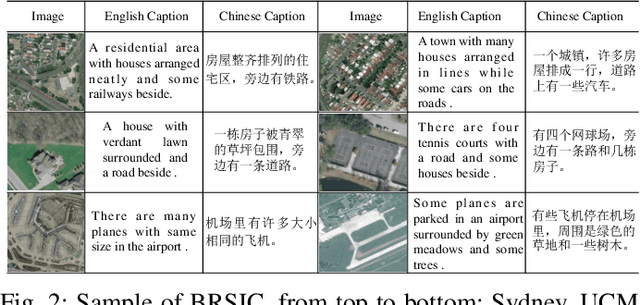
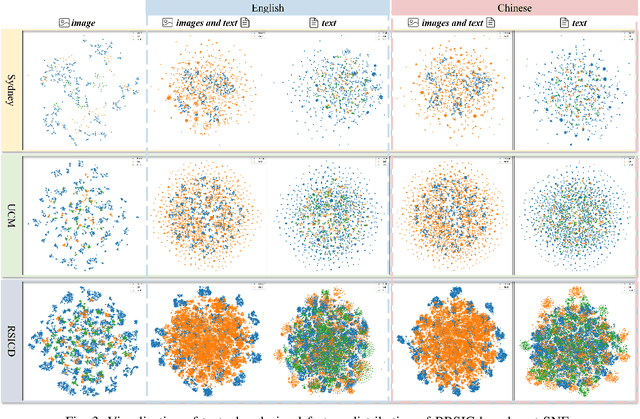

Abstract:Remote Sensing Image Captioning (RSIC) is a cross-modal field bridging vision and language, aimed at automatically generating natural language descriptions of features and scenes in remote sensing imagery. Despite significant advances in developing sophisticated methods and large-scale datasets for training vision-language models (VLMs), two critical challenges persist: the scarcity of non-English descriptive datasets and the lack of multilingual capability evaluation for models. These limitations fundamentally impede the progress and practical deployment of RSIC, particularly in the era of large VLMs. To address these challenges, this paper presents several significant contributions to the field. First, we introduce and analyze BRSIC (Bilingual Remote Sensing Image Captioning), a comprehensive bilingual dataset that enriches three established English RSIC datasets with Chinese descriptions, encompassing 13,634 images paired with 68,170 bilingual captions. Building upon this foundation, we develop a systematic evaluation framework that addresses the prevalent inconsistency in evaluation protocols, enabling rigorous assessment of model performance through standardized retraining procedures on BRSIC. Furthermore, we present an extensive empirical study of eight state-of-the-art large vision-language models (LVLMs), examining their capabilities across multiple paradigms including zero-shot inference, supervised fine-tuning, and multi-lingual training. This comprehensive evaluation provides crucial insights into the strengths and limitations of current LVLMs in handling multilingual remote sensing tasks. Additionally, our cross-dataset transfer experiments reveal interesting findings. The code and data will be available at https://github.com/mrazhou/BRSIC.
FGAseg: Fine-Grained Pixel-Text Alignment for Open-Vocabulary Semantic Segmentation
Jan 03, 2025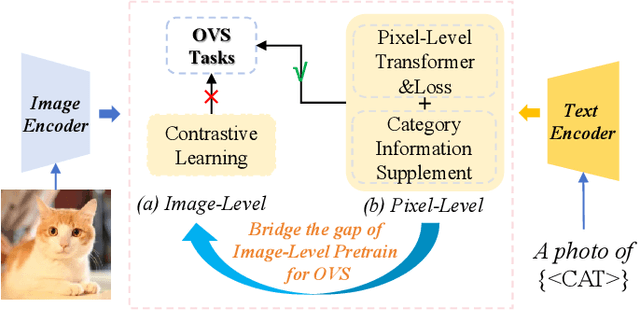
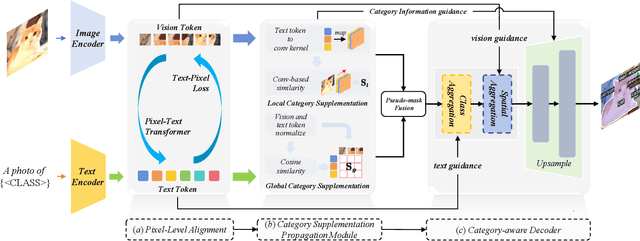
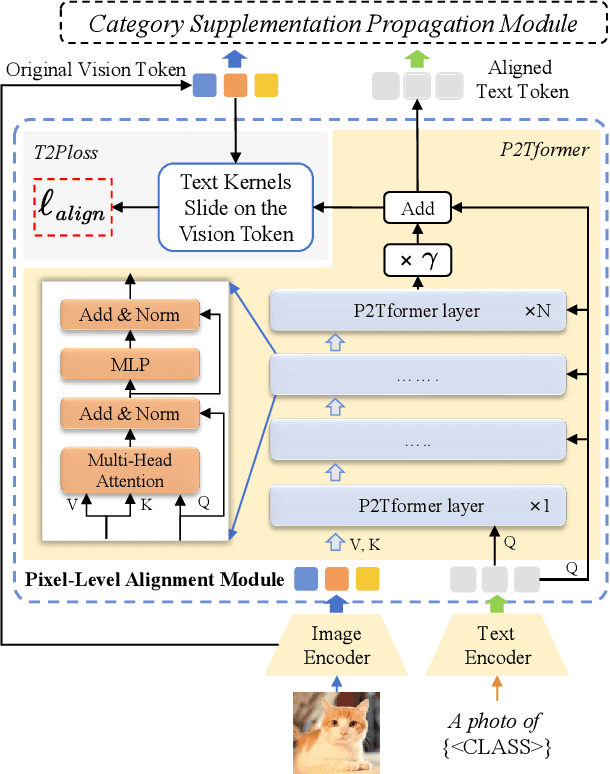
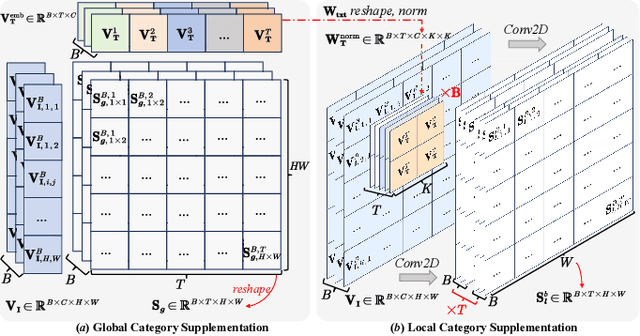
Abstract:Open-vocabulary segmentation aims to identify and segment specific regions and objects based on text-based descriptions. A common solution is to leverage powerful vision-language models (VLMs), such as CLIP, to bridge the gap between vision and text information. However, VLMs are typically pretrained for image-level vision-text alignment, focusing on global semantic features. In contrast, segmentation tasks require fine-grained pixel-level alignment and detailed category boundary information, which VLMs alone cannot provide. As a result, information extracted directly from VLMs can't meet the requirements of segmentation tasks. To address this limitation, we propose FGAseg, a model designed for fine-grained pixel-text alignment and category boundary supplementation. The core of FGAseg is a Pixel-Level Alignment module that employs a cross-modal attention mechanism and a text-pixel alignment loss to refine the coarse-grained alignment from CLIP, achieving finer-grained pixel-text semantic alignment. Additionally, to enrich category boundary information, we introduce the alignment matrices as optimizable pseudo-masks during forward propagation and propose Category Information Supplementation module. These pseudo-masks, derived from cosine and convolutional similarity, provide essential global and local boundary information between different categories. By combining these two strategies, FGAseg effectively enhances pixel-level alignment and category boundary information, addressing key challenges in open-vocabulary segmentation. Extensive experiments demonstrate that FGAseg outperforms existing methods on open-vocabulary semantic segmentation benchmarks.
SignEye: Traffic Sign Interpretation from Vehicle First-Person View
Nov 18, 2024Abstract:Traffic signs play a key role in assisting autonomous driving systems (ADS) by enabling the assessment of vehicle behavior in compliance with traffic regulations and providing navigation instructions. However, current works are limited to basic sign understanding without considering the egocentric vehicle's spatial position, which fails to support further regulation assessment and direction navigation. Following the above issues, we introduce a new task: traffic sign interpretation from the vehicle's first-person view, referred to as TSI-FPV. Meanwhile, we develop a traffic guidance assistant (TGA) scenario application to re-explore the role of traffic signs in ADS as a complement to popular autonomous technologies (such as obstacle perception). Notably, TGA is not a replacement for electronic map navigation; rather, TGA can be an automatic tool for updating it and complementing it in situations such as offline conditions or temporary sign adjustments. Lastly, a spatial and semantic logic-aware stepwise reasoning pipeline (SignEye) is constructed to achieve the TSI-FPV and TGA, and an application-specific dataset (Traffic-CN) is built. Experiments show that TSI-FPV and TGA are achievable via our SignEye trained on Traffic-CN. The results also demonstrate that the TGA can provide complementary information to ADS beyond existing popular autonomous technologies.
Real-Time Text Detection with Similar Mask in Traffic, Industrial, and Natural Scenes
Nov 05, 2024



Abstract:Texts on the intelligent transportation scene include mass information. Fully harnessing this information is one of the critical drivers for advancing intelligent transportation. Unlike the general scene, detecting text in transportation has extra demand, such as a fast inference speed, except for high accuracy. Most existing real-time text detection methods are based on the shrink mask, which loses some geometry semantic information and needs complex post-processing. In addition, the previous method usually focuses on correct output, which ignores feature correction and lacks guidance during the intermediate process. To this end, we propose an efficient multi-scene text detector that contains an effective text representation similar mask (SM) and a feature correction module (FCM). Unlike previous methods, the former aims to preserve the geometric information of the instances as much as possible. Its post-progressing saves 50$\%$ of the time, accurately and efficiently reconstructing text contours. The latter encourages false positive features to move away from the positive feature center, optimizing the predictions from the feature level. Some ablation studies demonstrate the efficiency of the SM and the effectiveness of the FCM. Moreover, the deficiency of existing traffic datasets (such as the low-quality annotation or closed source data unavailability) motivated us to collect and annotate a traffic text dataset, which introduces motion blur. In addition, to validate the scene robustness of the SM-Net, we conduct experiments on traffic, industrial, and natural scene datasets. Extensive experiments verify it achieves (SOTA) performance on several benchmarks. The code and dataset are available at: \url{https://github.com/fengmulin/SMNet}.
Conjugated Semantic Pool Improves OOD Detection with Pre-trained Vision-Language Models
Oct 11, 2024Abstract:A straightforward pipeline for zero-shot out-of-distribution (OOD) detection involves selecting potential OOD labels from an extensive semantic pool and then leveraging a pre-trained vision-language model to perform classification on both in-distribution (ID) and OOD labels. In this paper, we theorize that enhancing performance requires expanding the semantic pool, while increasing the expected probability of selected OOD labels being activated by OOD samples, and ensuring low mutual dependence among the activations of these OOD labels. A natural expansion manner is to adopt a larger lexicon; however, the inevitable introduction of numerous synonyms and uncommon words fails to meet the above requirements, indicating that viable expansion manners move beyond merely selecting words from a lexicon. Since OOD detection aims to correctly classify input images into ID/OOD class groups, we can "make up" OOD label candidates which are not standard class names but beneficial for the process. Observing that the original semantic pool is comprised of unmodified specific class names, we correspondingly construct a conjugated semantic pool (CSP) consisting of modified superclass names, each serving as a cluster center for samples sharing similar properties across different categories. Consistent with our established theory, expanding OOD label candidates with the CSP satisfies the requirements and outperforms existing works by 7.89% in FPR95. Codes are available in https://github.com/MengyuanChen21/NeurIPS2024-CSP.
 Add to Chrome
Add to Chrome Add to Firefox
Add to Firefox Add to Edge
Add to Edge